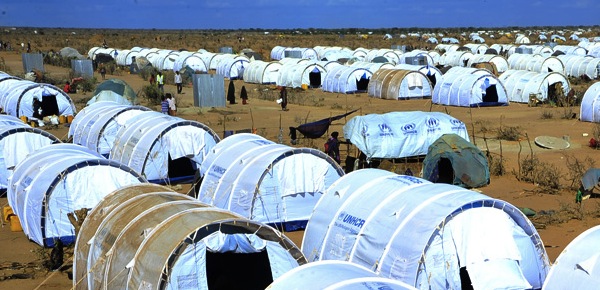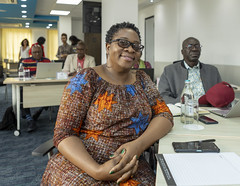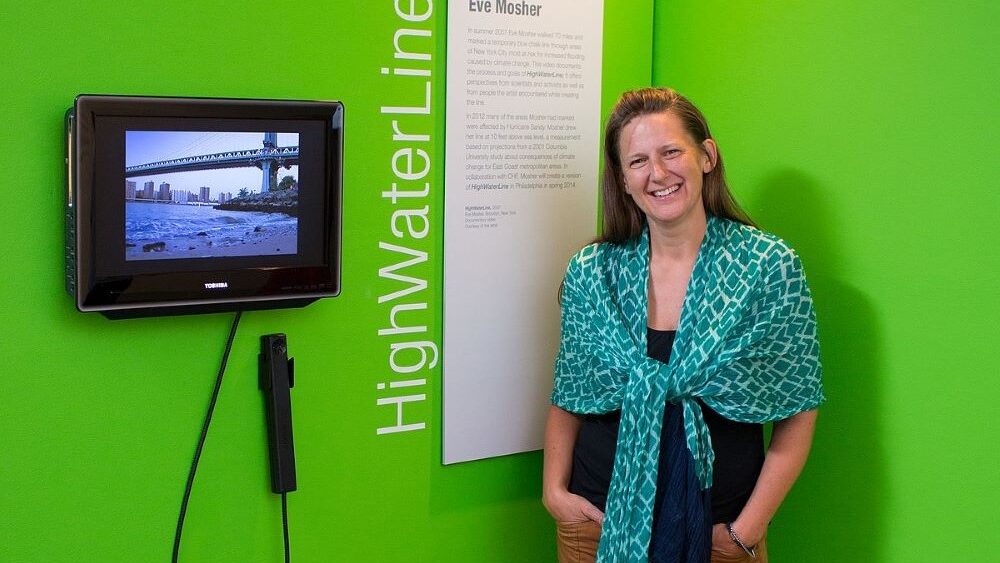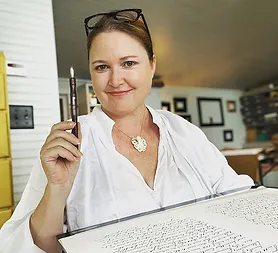Driven out by drought By Vikram Kolmannskog April 22, 2013 Global average temperatures are rising, and the weather is becoming wilder. The Intergovernmental Panel on Climate Change reports that climate change is a factor in certain disasters such as storms, floods and droughts. Population growth and density, poverty and armed conflicts are also contributing to a changing pattern in disasters. According to a study by the Internal Displacement Monitoring Centre, 14.9 million people were displaced by sudden-onset natural disasters in 2011; the majority by climate-related disasters such as storms and floods. Hundreds of thousands of others have fled slow-onset disasters, such as the drought that developed into a famine in the Horn of Africa. Among them are Somalis displaced to Kenya and Egypt. Those who flee persecution qualify for refugee status, according to the refugee definition of the 1951 United Nations Convention Relating to the Status of Refugees and its 1967 Protocol. There are wider regional refugee definitions such as the Convention Governing the Specific Aspects of Refugee Problems adopted by the Organization of African Unity (OAU) in 1969. This classified generalized violence and events seriously disturbing public order in the definition. For many of those displaced to another country in the context of disasters, however, there is no international legislation providing a clear and secure basis for their rights and protection. The Kenyan and Egyptian contexts offer an opportunity to understand what this means for people on the ground. Between Conflict and Drought in Somalia Somalia comprises Somaliland, which has declared itself independent, Puntland, which has declared itself an autonomous state, and South Central Somalia. In South Central Somalia armed opposition groups, government, and African Union (AU) troops are all fighting for control. And there are many, sometimes conflicting, foreign interests. Somalia is one of the poorest and most violent countries in the world. The majority of the approximately nine million inhabitants are nomadic pastoralists and seasonal farmers. The rain-dependent livelihoods, poverty, and conflict make people very vulnerable to climate change and disasters. Droughts have become routine in the last decades. When rain does come, it often comes in sudden and massive proportions so the soil cannot absorb it. These droughts and floods come on top of the ongoing armed conflict. While most East African countries were badly affected by drought in 2011, the situation was almost beyond imagination in Somalia with famine being declared in several regions. It was the most severe humanitarian crisis in the world in 2011, and Africa’s worst food security crisis since the Somali famine between 1991−92. Experts see two primary causes for the famine. First, the total failure of the October to December Deyr rains in 2010 and the poor performance of the April to June Gu rains in 2011 resulted in the worst annual crop production for seventeen years, high animal mortality, and soaring food prices. Second, humanitarian assistance was extremely limited until September 2011 due to inadequate funding and intervention by the international community—and armed groups severely restricting humanitarian access. “During previous droughts, we could live off livestock or even sell some livestock to survive,” says a man named Yussuf before describing the 2011 drought. “Now all the livestock is dying, even the donkeys. It is the worst drought I have experienced.” He is an older Somali gentleman with a characteristic henna-dyed beard. He has been a pastoralist and seasonal farmer his whole life. He describes how his family lost the majority of their animals to the drought then sold the rest to survive, because nothing grew on the farm. The drought was so severe that normal coping mechanisms were not sufficient. “Before family and clan members used to help each other, but now nobody has anything,” he explains. Yussuf, who believes the drought and famine were God’s will, says that armed groups played a role by not allowing international organizations access to people in need for a very long time. Eventually, he decided to leave together with his family. However, the armed group controlling the area where they were living would not even allow them to leave. They wanted to hold on to people and power. “We had to sneak out at night,” he says. Can one speak of displacement in a pastoralist context? The Somali pastoralists have always been on the move. It is their way of life. According to Yussuf, last year was different, though. “I was forced to leave by the circumstances,” he says. It was not like previous droughts when they could still go to the traditional areas of pasture and let the animals graze. The pastoralist has now been forced to settle. Conventions and Protocols In July 2011, Yussuf and his family arrived in search of basic assistance at the Dadaab refugee camp in Kenya, the largest such settlement in the world with some half a million mostly Somali inhabitants. By September 2011, more than 140,000 new refugees had entered Dadaab. The Kenyan response to Somalis fleeing drought, conflict, and famine in 2011 and 2012 is a mixed picture. Kenya is party to the UN convention and protocol as well as to the 1969 OAU convention. There is also domestic legislation such as the 2006 Refugees Act. While Kenyan authorities have delegated most issues concerning refugees to the United Nations High Commissioner for Refugees (UNHCR), including refugee status determination, it is increasingly assuming responsibilities. Due to the generalized violence, the government of Kenya and UNHCR officials in Kenya consider that all people coming from South Central Somalia are refugees according to the OAU definition. While Kenya insists that refugees are welcomed and not rejected, the Kenyan-Somali border has been officially closed since 2007. According to the Refugee Consortium of Kenya, the continued refusal to open the border and the lack of access to nutrition, health, water, transport, and other essentials at the border amounts to an extraordinary protection failure, contributing for several months to excess mortality in the first days of arrival in the camps. The Kenyans do not patrol the whole length of the border, however, and it is highly permeable, but the closure forces many Somalis to take more dangerous routes to enter the country. Yussuf and his family spent fifteen days travelling, much of the time on foot. They were not stopped by police or soldiers, but they were attacked by bandits operating along the border. In October 2011, the Kenyan government stopped registering new refugees. Those who are not registered only qualify for the most basic assistance. The Refugee Consortium of Kenya believes that the increase in people coming mainly due to drought and livelihood insecurity can undermine theprima facie refugee status in the long run. “It is better here than in Somalia,” Yussuf says and pauses for a moment. “But we solely depend on food rations here. I would have preferred to have livestock and a small farm, or trade in animals, since this is what I am used to.” Formally, Somalis in Kenya have very limited freedom of movement and right to work. They are confined to the camps where they receive assistance from humanitarian and development organizations. Schooling and new training offers hope to some. While agro-pastoralism has been an adaptation to the climate of Somalia, Yussuf is glad that his children are going to school and can perhaps have other livelihoods in the future. “I would like one of them to become a doctor because health is important,” he says. “Another could be a driver so we can move around more easily. The third one could learn about the world and different cultures because that too is important.” Pros and Cons for Kenyans The location of the refugee camp in Dadaab is important. The North Eastern Province is ethnically Somali. It is an arid to semi-arid region, and has historically been marginalized. The displaced Somalis and members of the local Kenyan community emphasize that the relationship between the two groups is good. “They are Somalis and our brothers and sisters,” says a man named Abdirashid, a teacher at the primary school in the town of Dadaab. “There is only a line that the colonial government drew between us. We have a very good interaction. We intermarry, work for them, they work for us, we work together. They are like us.” Abdirashid, who is also the secretary for a local environment committee, has invited us into his office where a group of local women and youth representatives are waiting. The Kenyans in Dadaab admit that there are many benefits to the refugee camps. “The Somalis are very enterprising people and there is more business here now,” says Abdirashid. A socio-economic survey in 2010 suggested that, while there are some negative environmental impacts in the immediate vicinity, the camp brings in approximately $14 million annually, equating to around 25 percent of the region’s per capita income. Local Kenyans have their complaints, however. “The first effect of the refugees was that our grazing area is now a refugee camp,” Abdirashid explains. “In addition, they go and cut trees. This is already a fragile ecosystem. Any drought becomes more severe here.” The 2011 drought had a strong impact on Dadaab and Kenya in general as well as Somalia. “I just think it is sad that we have not been compensated,” he says. “There is all that hype about the refugees. We have waited. They had serious problems, but now some refugees even have a higher standard of living than us.” When asked what they expect from the government and what they expect from the international agencies, the answer is first a smile. “We don’t expect anything from the government,” he says. “There is too much corruption. Kenya has neglected this area since colonial times. We are second-class Kenyans. Now all the money goes to security. No money for development. Hopefully, we will soon get a new government which will help.” The Egyptian Context Egypt is a refugee-receiving as well as transit country. According to a UNHCR official, there was a slight increase in Somali asylum seekers in Egypt during 2011, and part of this might be attributed to the drought and famine. Another reason may be that people wanted to have their status regularized and be protected by the agency or be resettled, due to uncertain times after Egypt’s January 25 revolution. “I was on the verge of a mental breakdown,” Ahmed says. We are sitting around a table with a group of young Somali men in Cairo. Ahmed pauses and adjusts his glasses. He has just told us how his family lost their livestock, he lost his transport job, his uncle died of hunger. Together with his family he went to a camp for internally displaced people in Mogadishu in search of basic assistance. But for a long time armed groups did not give international organizations access to the people in need. “Drought and civil war are twins that have come together to plague my country,” Ahmed says. Eventually, he saved up enough money and made contacts to leave the country. He had a long journey from Somalia to Egypt. “I started in Ethiopia where I met some Oromo people. I went with them through Ethiopia and to Sudan. We traveled through Sudan for three months. I crossed the desert. I suffered.” Egypt is one of the few countries in the Middle East and North Africa region that is party to the UN and OAU conventions. In addition, there is another regional draft convention, the Arab Convention on Regulating Status of Refugees in the Arab Countries. Article 1 of the convention explicitly recognizes as refugees those who flee “because of natural disasters or grave events resulting in major disruption of public order in the whole country or any part thereof.” The convention must be ratified by the Arab League before it is presented to each Arab state for ratification. In Egypt today, there is individual refugee status determination, which means that each individual must show that he or she meets all criteria in one of the currently binding refugee definitions. As in Kenya, UNHCR assists the government in status determination. “People would not come to the office and say that they came due to drought,” says a UNHCR official. Those displaced would emphasize the conflict element. Due to the multi-causality of their movement, some are recognized as refugees. Others adapt their narratives and are also recognized. Many others, however, are rejected. “In Egypt the Oromo helped me and took me to the UNHCR office in Cairo,” Ahmed says. “I told them how I lost family in the drought and fighting. I have now got the yellow card [the UNHCR identity document for asylum seekers] and am waiting.” Dreams and Nightmares We talk about life in Egypt and hopes for the future. “I do anything, I clean, I do anything to survive,” Ahmed says. “It is tough since foreigners are not really allowed to work here.” Egypt has limited the rights of refugees to work, education, health services, and permanent residency. The young Somali men see little future in Egypt. “One of the main challenges is that all of us are very depressed,” Ahmed continues. “We are in the middle. A friend of mine tried crossing from Libya over to Italy and died in the Mediterranean. If we try to go to Europe, we die in the Mediterranean. In Somalia we die of conflict and drought. The solution is in the hands of Allah.” According to UNHCR, more than 1,500 irregular migrants or asylum seekers drowned or went missing in 2011 while attempting to cross the Mediterranean Sea. A series of factors influence developed countries’ will to accept refugees, and at the moment the will is little. Several European countries have elaborate legislation protecting refugees. In practice, however, many of them try—through visa regulations, interceptions, and other measures—to make sure that as few asylum seekers as possible ever arrive in their countries to be able to enjoy this protection. Some people in search of better lives elsewhere persevere in their journey and struggle regardless. When someone in the group says that everyone wants resettlement to Europe or North America, Ahmed exclaims, “Not me! I need to return back home. As long as I am not home, I am losing time. If there was security and I had a ticket in my hand, I would return home today!” We talk about what he could do if only there was peace and prosperity in Somalia. “I would like to open a garage. If there was peace, people would support and trust me.” Someone else in the group wants to open a restaurant and a hotel on the beach in Kismayu, “tourists can come and sunbathe, swim in the sea, eat, and sleep well.” The young men drift off into dreams about a future Somalia. In the second half of 2012, there were signs of optimism in parts of the country following a presidential election, and people, including returning diaspora Somalis, are seeking to establish new lives and businesses. Refugees from Disasters For Somalis displaced to Kenya and Egypt, the lack of livelihood options was one of the main reasons for leaving home. The armed conflict and lack of humanitarian access played an important role in escalating the drought and famine. In terms of preventing displacement, this implies that livelihood interventions are necessary, and that we have to somehow address the complex, on-going armed conflict. The movement out of Somalia was experienced as forced displacement. This creates a particular humanitarian imperative to act. Addressing root causes of displacement is also related to the facilitation of return. For return to even be an option, peace and better livelihood opportunities are necessary. The Kenyan and Egyptian responses to the Somali displacement illustrate how the gap in legal protections plays out on the ground. In Kenya, the most pressing challenges seemed to be less related to the formal recognition of refugee status. Somalis experienced difficulties in crossing the border and challenges such as lack of training and livelihood opportunities. These challenges are probably similar to those of many other refugees in Dadaab and elsewhere in large camps. In Egypt, the Somalis were subjected to individual refugee status determination and had to show a clearer link to persecution or conflict. In these cases, narratives were sometimes adjusted, and many risked not being recognized as refugees and getting formal legal protection. Challenges included those related to work and mental health. This illustrates the importance of initiatives to address the challenges of applying the traditional refugee concept in drought and disasters. Developing regional instruments such as the Arab convention, which explicitly recognizes such disasters, might be one way forward. While developing new formal legislation remains important, other contextual factors are crucial in determining whether rights protection is effective or not. This applies both to the Kenyan and Egyptian cases as well as to Europe and developed countries. This essay is adapted from Somali Voices From Displacement in Kenya and Egypt, published by the Norwegian Refugee Council in December 2012. Photo: Dadaab camp, providing shelter for Somalis fleeing drought, Dadaab, Kenya, July 30, 2011. Alex Kamweru/Demotix/Corbis Vikram Kolmannskog is a human rights lawyer and has served as an independent advisor and consultant to the Norwegian Refugee Council since 2007. He has contributed to the Journal of International Development, International Review of the Red Cross, and Forced Migration Review, among others.
Perspective















